1951 Chevrolet 3600 - Haulin' Hog! 

Even Great Working Trucks Get To Retire With Dignity
From the November, 2010 issue of Custom Classic Trucks
By Eric McClelland

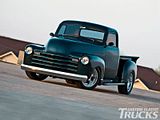 Wayne and Barbara Charles of Rosemount, Minnesota, went looking for a big, loud, and sleek muscle car to call their own. They searched high and low for the right one, yet nothing seemed to do the trick. One was not the right color, another was too flashy, and yet another was just not their style. You see, what they didn't know was that the right car for them wasn't a car at all; it was a truck. All of the frustration they suffered in trying to find a recreational toy was part of a bigger plot they couldn't yet see. Wayne and Barbara Charles of Rosemount, Minnesota, went looking for a big, loud, and sleek muscle car to call their own. They searched high and low for the right one, yet nothing seemed to do the trick. One was not the right color, another was too flashy, and yet another was just not their style. You see, what they didn't know was that the right car for them wasn't a car at all; it was a truck. All of the frustration they suffered in trying to find a recreational toy was part of a bigger plot they couldn't yet see.
Wayne's problem wasn't that the cars were wrong or bad. He just didn't have an emotional attachment to any of them to match what he had with only one other vehicle during his lifetime. As it turns out, the vehicle he was searching for was right under his nose the entire time. A vehicle that was purchased by Wayne's father in the late 1950's in which he learned to drive at age 12 on the farm: a '51 Chevrolet 3600 pickup.
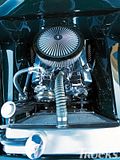 As fate would have it, this very truck was still at the farm under 30 years of dust, mice, rust, and bird droppings. But have no illusions that this was some prized "barn find" that was well preserved by the ravages of time. No, this was a strict work truck and much like everything else on the farm, earned its keep. It spent the majority of its life with a wooden box, hauling hogs to market. Oftentimes the truck would be full of feed for an entire week. The hogs would use the truck as a scratching post and for other pig-type duties. As fate would have it, this very truck was still at the farm under 30 years of dust, mice, rust, and bird droppings. But have no illusions that this was some prized "barn find" that was well preserved by the ravages of time. No, this was a strict work truck and much like everything else on the farm, earned its keep. It spent the majority of its life with a wooden box, hauling hogs to market. Oftentimes the truck would be full of feed for an entire week. The hogs would use the truck as a scratching post and for other pig-type duties.
At age 13, Wayne was allowed to take the truck to the market by himself, but only in the winter. Wayne figured out quickly why he was given such responsibility at an early age, the heater was broken. A couple years later the truck was used as a hunting truck to schlep him to and from the duck marshes. At age 18 Wayne bought a car and forgot about the Chevy. It continued to see service up until 1974 when it was retired to the barn, to some day be resurrected.
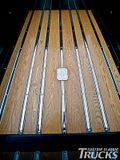 The body was in rough shape due to normal farm work: climbing on, walking on, and sitting on panels that were never designed for that sort of activity. But, Wayne was able to preserve the original fenders even if it would have been more financially prudent to purchase new ones. Wayne had to replace the front driver door hinges and cowl panel after catching it on the barn while prying the carcass out of retirement. Wayne completed the subframe and soon realized that he was in way over his head as he had zero fabrication experience and needed help. The exterior got lots of love from Bob Lampher at Bob's Rod Shop in Savage, Minnesota. The top was chopped 2 inches, the door handles shaved, the taillights frenched, the firewall recessed, the fenderwells smoothed, and the headlights frenched as well, all in an effort to give the truck a sleek and modern look. The body was in rough shape due to normal farm work: climbing on, walking on, and sitting on panels that were never designed for that sort of activity. But, Wayne was able to preserve the original fenders even if it would have been more financially prudent to purchase new ones. Wayne had to replace the front driver door hinges and cowl panel after catching it on the barn while prying the carcass out of retirement. Wayne completed the subframe and soon realized that he was in way over his head as he had zero fabrication experience and needed help. The exterior got lots of love from Bob Lampher at Bob's Rod Shop in Savage, Minnesota. The top was chopped 2 inches, the door handles shaved, the taillights frenched, the firewall recessed, the fenderwells smoothed, and the headlights frenched as well, all in an effort to give the truck a sleek and modern look.
The old wooden box was ditched for a metal box from Bruce Horkey with white oak bed wood. A third brakelight was added to give it a modern look and the rear roll pan and the tailgate are smoothed Pro's Pick items. All topped off with a custom dark-metallic green from Sikkens done by Bruce Tschida of Lake Marion Collision in Lakeville, Minnesota. Naturally, Wayne's wife, Barb, came to the rescue and helped Wayne pick the perfect color.
 Good looks aren't the only trick to this pretty face. Wayne stuffed a 383 small-block he built himself using a short block he purchased from The Engine Store in Winona, Minnesota. Using iron cylinder heads, Wayne and Bob plugged in a Comp Cams 274H cam and prepped it for a 10:1 compression ratio. Helping the engine breathe on the intake is a K&N filter fed into a 650-cfm Holley and an Edelbrock Air-Gap intake manifold. On the exit, gasses are passed through a set of Sanderson 13/4-inch headers fed into a 21/2-inch MagnaFlow exhaust system. Wayne predicts this combo is good for roughly 400 hp at the flywheel. Master Transmission of Rosemount, Minnesota, provided the GM 200-4R and a 2,500-stall converter. A Walkie's Radiator coupled with a stock water pump and an electric fan keep things cool under the hood. Good looks aren't the only trick to this pretty face. Wayne stuffed a 383 small-block he built himself using a short block he purchased from The Engine Store in Winona, Minnesota. Using iron cylinder heads, Wayne and Bob plugged in a Comp Cams 274H cam and prepped it for a 10:1 compression ratio. Helping the engine breathe on the intake is a K&N filter fed into a 650-cfm Holley and an Edelbrock Air-Gap intake manifold. On the exit, gasses are passed through a set of Sanderson 13/4-inch headers fed into a 21/2-inch MagnaFlow exhaust system. Wayne predicts this combo is good for roughly 400 hp at the flywheel. Master Transmission of Rosemount, Minnesota, provided the GM 200-4R and a 2,500-stall converter. A Walkie's Radiator coupled with a stock water pump and an electric fan keep things cool under the hood.
To keep things cool in the passenger compartment, Wayne installed an A/C kit from Hot Rod Air. The simple and clean look is continued into the interior with custom upholstery by Paul Lovas from Rivertown Upholstery in Stillwater, Minnesota. Paul stretched the tan leather over a set of buckets borrowed from a wrecked '97 Cadillac Sedan De Ville, also borrowing a steering column from an '86 Monte Carlo united with a Billet Specialties wheel to keep this truck on the right track. An Alpine head unit embedded in a custom center console powers a set of 8-inch Pioneer speakers for when Wayne and Barbara get tired of the road noise. A pair of gauges from Classic Industries keeps all the vitals in check.
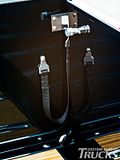 Wheels are a tasteful American Racing Hoopster rim, 18x7 up front and 18x8 in the back, all wrapped in Goodyear F1GSD3's, 235/50R18 and 255/55R18 respectively. All that rolling goodness is held down by a stock 3/4-ton boxed frame that was shortened 91/2 inches to make it a 1/2-ton truck. The front suspension is provided from a Mustang II and Fatman Fabrications using a 2-inch drop to add to the aggressive stance. Four-wheel power disc brakes make sure to reign back on the stroker at times of spirited driving. The rear suspension is capped off with a 10-bolt rearend borrowed from a '93 GMC Typhoon with 3.42 gears and a limited-slip differential. Wheels are a tasteful American Racing Hoopster rim, 18x7 up front and 18x8 in the back, all wrapped in Goodyear F1GSD3's, 235/50R18 and 255/55R18 respectively. All that rolling goodness is held down by a stock 3/4-ton boxed frame that was shortened 91/2 inches to make it a 1/2-ton truck. The front suspension is provided from a Mustang II and Fatman Fabrications using a 2-inch drop to add to the aggressive stance. Four-wheel power disc brakes make sure to reign back on the stroker at times of spirited driving. The rear suspension is capped off with a 10-bolt rearend borrowed from a '93 GMC Typhoon with 3.42 gears and a limited-slip differential.
Wayne's father unfortunately passed away before he could see the truck brought back to its former glory but Wayne surmises that his dad always had plans of restoring it, which is why he kept it tucked away for so long. We may never know the reason he never scrapped it, but everyone is sure glad he didn't, because now Wayne and Barbara have everything they have ever wanted: a modern, functioning hot rod that can pound the pavement and a direct link to those boyhood memories that can never be abandoned.
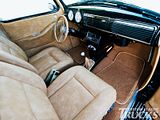

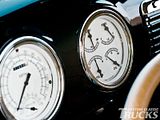
|